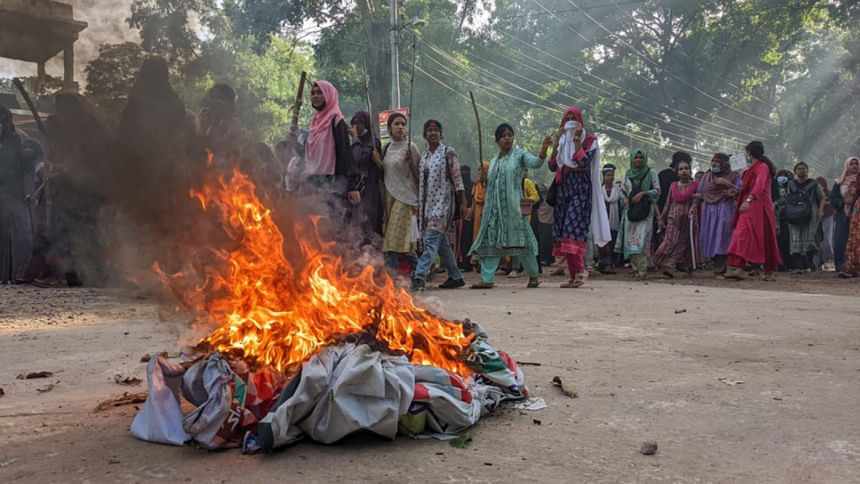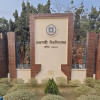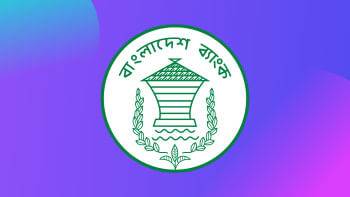From fear to defiance: How Rajshahi University stood up on July 16

On this day, July 16, 2024, during the July Uprising in Bangladesh, Rajshahi University witnessed a defining moment. For the first time in its history, members of the Bangladesh Chhatra League (now a banned organisation) were forced to flee the campus, turning their backs in the face of thousands of outraged students.
The incident took place shortly after 3:00pm. BCL activists -- some wielding sticks and stationed on motorcycles in front of Madar Bux Hall -- were attempting to block students from joining the protest. But within moments, a tidal wave of students emerged from various residential halls -- Shaheed Suhrawardy Hall, Shaheed Shamsuzzoha Hall, Abdul Latif Hall, and Amir Ali Hall. They marched together, cornered the BCL men. The activists, shocked by the unexpected student turnout, fled the campus on their motorcycles through the Station Bazar gate. Since that day, Rajshahi University remains free from Chhatra League control -- marking the first such incident across all campuses during the anti-quota movement.
This event was not a sudden outburst, but the result of days of planning, simmering frustration, fear, and courage.

On July 15, 2024, quota protesters at Dhaka University -- including female students -- came under attack by Chhatra League members. The news spread rapidly, igniting outrage across the country. Later that day, students at Rajshahi University wanted to protest in solidarity, but fear of violence held them back. The RU unit of Chhatra League had already been issuing threats against protesters, and no public demonstration was announced on campus that day.
Mokarrom Hossain, a 2020–21 Economics student and key coordinator of the anti-quota movement at RU, shared how fear initially silenced many.
"We had an 18-member coordination team but kept it secret due to Chhatra League threats," he said.
On July 15, with hesitation among the group members, Mokarrom boldly announced a protest for the next day on Facebook, urging students to overcome their fear. The following morning, he called for donations to buy sticks for self-defense and quietly coordinated their purchase in secret.
"As Chhatra League activists locked and occupied the hall gates, our team gathered at Kazla, hiding sticks in sacks. Around 700 to 800 students joined us near Binodpur almost immediately. I then went live on Facebook to rally more supporters," he said.
"Our goal was to ensure the participation of female students, and by 3:00pm, thousands had flooded the campus. I can't remember the last time Rajshahi University saw a gathering of that scale. No one stayed in their rooms that day as Chhatra League men had been attacking our brothers across the country," he said.
"However, despite Chhatra League's attempts to stop us, thousands of students stood united and drove them out. Their power vanished in an instant. Since then, Rajshahi University has remained free from Chhatra League's oppression."
Shihab Uddin, a resident of Shaheed Ziaur Rahman Hall who was attacked by Chhatra League men on July 16, shared his experience. "It all started after female students at Dhaka University were attacked on the 15th. We wanted to protest, but Chhatra League chased us. We so felt helpless," he said.
On the night of July 15, after hearing reports of more assaults across the country, Shihab and his friends decided to go for action. They fashioned batons from mosquito-net stands and made placards using shoe bags. On the next morning, he messaged fellow students, urging them to join.
"We planned to move as a group so we wouldn't be chased off again," he said.
He wore a mask and carried toothpaste to defend against tear gas. At 2:20pm, they launched a small rally -- but were soon attacked by Chhatra League activists.
"I was the first to be hit. Everyone scattered. They beat me with sticks and stumps. Injured, I was hidden in a dorm room by fellow students," he said.
"Later, I learned Chhatra League had fled the campus," he said.
Rajshahi University Pro Vice-Chancellor (Academic) Farid Uddin Khan, who also expressed support for the student protest, explained the deeper causes behind the uprising.
"Chhatra League had long controlled the dormitories. Without paying them, students couldn't get seats. And those who did were subjected to mental pressure through the notorious 'guest room' culture," he said.
"Political favoritism ruled the campus. General students had no freedom, no voice. So when the quota movement began, it ignited with full force here. It wasn't just a fight for fair policy -- it was a fight for dignity."
He sees the July 16 protest as a historic milestone.
"This wasn't just a demonstration -- it was a victory by the students of Rajshahi University against years of oppression. They set an example no other university had. Yet this chapter has never received the recognition it truly deserves," said Farid Uddin.


 For all latest news, follow The Daily Star's Google News channel.
For all latest news, follow The Daily Star's Google News channel. 








Comments